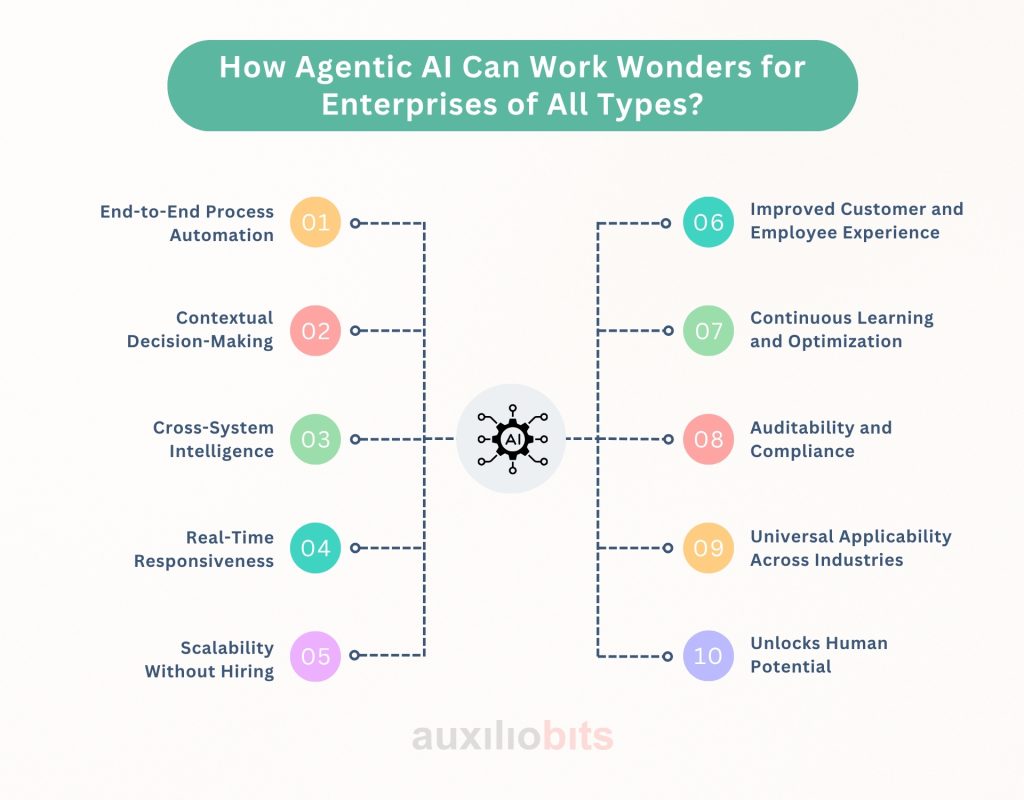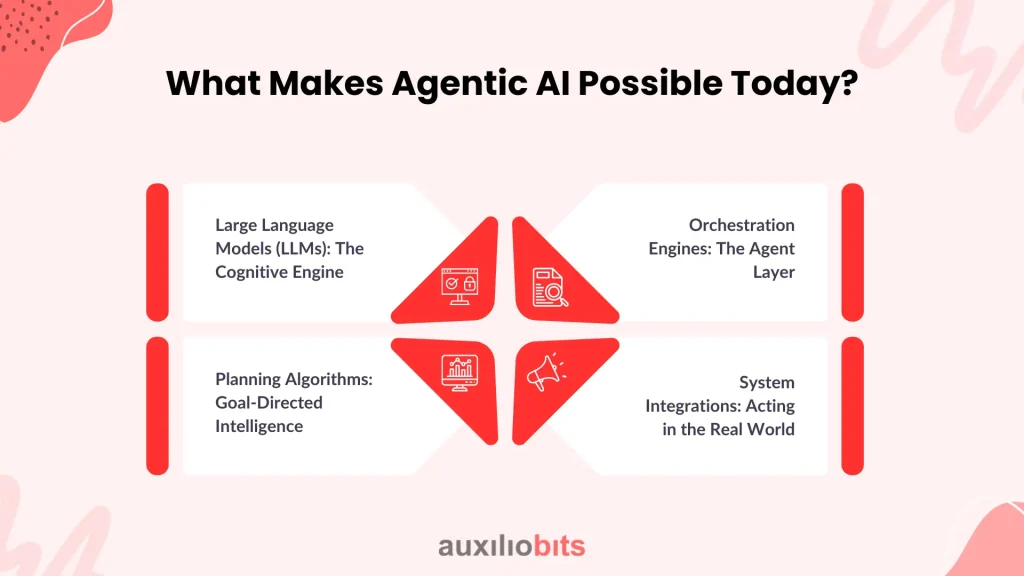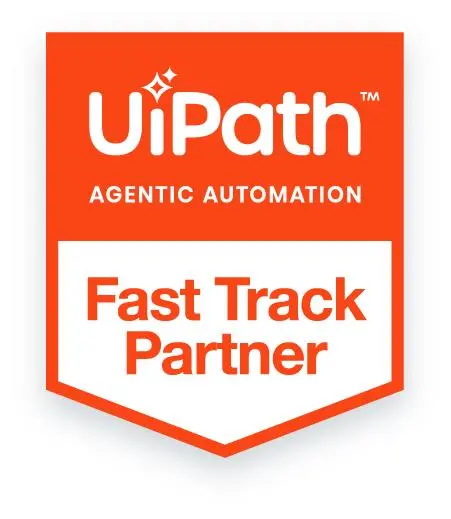
Key Takeaways
- Agentic AI Agents go beyond task automation to achieve goal-driven outcomes by perceiving, planning, and acting autonomously across enterprise systems with minimal human intervention.
- Traditional automation lacks adaptability and breaks under exceptions—Agentic AI solves this by enabling context-aware, real-time decision-making through multi-step planning and reasoning capabilities.
- Powered by LLMs, orchestration engines, and planning algorithms, Agentic AI Agents understand unstructured data, dynamically sequence actions, and integrate across cloud, on-premise, and legacy systems.
- These agents scale operations without headcount, improve SLA adherence, reduce manual handoffs, and enhance customer and employee experience across sectors like finance, manufacturing, and healthcare.
- Enterprises using Agentic AI gain continuous optimization, transparent audits, and strategic agility—paving the way for intelligent, autonomous processes that align with modern business demands.
Over the past decade, enterprises have invested heavily in automation technologies—from Robotic Process Automation (RPA) bots that mimic mouse clicks to advanced optical character recognition (OCR) systems that digitize paperwork. These efforts have brought efficiencies, but often in fragments. Processes still require manual escalations, context-based decision-making, and human “stitching” across systems.
What’s missing? Tools can execute tasks, but they can’t independently understand intent, coordinate across departments, or adapt to changing business environments.
Enter Agentic AI Agents. These are intelligent, goal-oriented software entities that perceive, reason, and act without constant human intervention. Unlike traditional bots, Agentic AI Agents don’t just automate tasks; they pursue outcomes.
As enterprises face increasing complexity, rising expectations, and the need for 24/7 operational fluidity, Agentic AI Agents are emerging as the foundation for the intelligent, autonomous enterprise.
Also read: RPA in 2025: Trends, Tools, and What CIOs Should Prepare For
What Is an Agentic AI Agent?
At its core, an Agentic AI Agent is a software agent that combines artificial intelligence, multi-step planning, contextual understanding, and autonomy to execute business outcomes.
It doesn’t just follow rules—it thinks in terms of goals.
Imagine an agent that:
- Understands a business email asking for vendor approval
- Pulls relevant documents from SharePoint
- Validates supplier data from ERP
- Flag inconsistencies using policy logic
- Sends an update to procurement—all without a single human click
Definition: Agentic AI Agents are digital entities with the cognitive ability to sense, plan, act, and adapt autonomously toward achieving enterprise goals.
Why Traditional Automation Falls Short?
Even with RPA, workflow engines, and AI tools in place, most enterprises still struggle with fragmented operations.
Common pain points:
- Manual handoffs between systems
- Exceptions that bots can’t handle
- Siloed data that lacks contextual interpretation
- Low adaptability to business changes
- Humans are constantly monitoring or fixing bot failures.
Why?
Because most automation today is scripted and static. It lacks adaptability, reasoning, and actual end-to-end ownership of a process. Agentic AI addresses this by enabling dynamic, context-aware, and goal-oriented execution.
Key Capabilities of Agentic AI Agents
Let’s unpack what makes Agentic AI Agents different:
| Capability | Description |
| Goal-Driven Behavior | Operates with the end outcome in mind (e.g., “complete onboarding”) instead of a single task |
| Autonomous Execution | Executes across systems without manual triggers |
| Contextual Understanding | Interprets structured + unstructured data (emails, PDFs, ERP records) |
| Multi-Step Planning | Plans a sequence of steps based on real-time data |
| Conversational Interfaces | Interacts with users via chat, voice, or email |
| Learning & Adaptation | Continuously improves from feedback and outcomes |
| Cross-System Action | Uses APIs, RPA, and UI automation to act across legacy and modern tools |
How Agentic AI Can Work Wonders for Enterprises of All Types?
Whether you’re in manufacturing, healthcare, finance, logistics, or retail, Agentic AI Agents can reshape operations by automating outcomes, not just tasks. Here’s how they deliver transformative value:

1. End-to-End Process Automation
- Automates complete workflows (e.g., from request to approval, intake to resolution)
- Eliminates human handoffs, reducing delays and rework
- Ensures processes run 24/7 without manual intervention
2. Contextual Decision-Making
- Understands unstructured data like emails, PDFs, and chat
- Applies business rules and reasoning to make wise decisions
- Handles exceptions and escalations dynamically
3. Cross-System Intelligence
- Connects and acts across ERP, CRM, HRMS, and legacy systems
- Removes the need for humans to “stitch” information across tools
- Operates seamlessly in hybrid environments (cloud + on-premise)
4. Real-Time Responsiveness
- Reacts instantly to triggers (incoming orders, form submissions, escalations)
- Adjusts plans based on current data and events
- Supports just-in-time decisions in operations, customer service, and supply chain
5. Scalability Without Hiring
- Adds capacity instantly without needing more headcount
- Deploys agents modularly—scale one process or many
- Reduces dependency on human availability and training
6. Improved Customer and Employee Experience
- Speeds up cycle times for requests, onboarding, or claims
- Reduces SLA violations and missed follow-ups
- Enables self-service, instant answers, and proactive updates
7. Continuous Learning and Optimization
- Learns from every interaction or exception
- Improves accuracy, timing, and decision quality over time
- Enables data-driven tuning of processes
8. Auditability and Compliance
- Logs every action, decision, and outcome for review
- Supports regulated industries with built-in explainability
- Reduces manual errors and compliance risks
9. Universal Applicability Across Industries
- Manufacturing: Automates production planning, vendor onboarding, and maintenance workflows
- Finance: Speeds up invoice processing, reconciliations, and credit checks
- Healthcare: Accelerates claim approvals, pre-authorizations, and patient communications
- Logistics: Orchestrates inventory, shipment, and delivery status updates
- Retail: Automates customer service, returns, and supply-chain coordination
10. Unlocks Human Potential
- Frees up employees from repetitive and reactive tasks
- Allows teams to focus on strategy, innovation, and exception handling
- Builds a digitally fluent, outcome-focused organization
What Makes Agentic AI Possible Today?
Agentic AI wasn’t feasible just a few years ago. But thanks to a convergence of breakthroughs in AI reasoning, orchestration, infrastructure, and integration, enterprises can now deploy intelligent agents that don’t just follow instructions—they plan, act, and improve autonomously.
Let’s break down the key building blocks that enable Agentic AI to work today:

1. Large Language Models (LLMs): The Cognitive Engine
LLMs like GPT-4 Claude, PaLM, and LLaMA have fundamentally changed what software can understand and generate.
What They Enable:
- Natural Language Understanding: LLMs can read unstructured data, such as emails, PDFs, forms, and support tickets, and extract meaning, sentiment, and intent from them.
- Context Awareness: They maintain context across conversations, threads, and process states, which is vital for multi-step workflows.
- Human-like Reasoning: LLMs can analyze situations, evaluate alternatives, and generate policy-compliant decisions, summaries, or next steps.
Enterprise Impact:
With LLMs, agents can “read” emails, “understand” contracts, “compare” documents, or “decide” if an invoice should be approved—all without pre-programmed rules.
2. Planning Algorithms: Goal-Directed Intelligence
Traditional bots execute predefined scripts. Agentic AI agents must think ahead, plan sequences, make informed decisions, and adapt dynamically to changing environments.
Tools That Power This:
- ReAct (Reasoning + Acting): Allows agents to decide when to “think” vs. when to “act.”
- AutoGPT / BabyAGI: Enable agents to autonomously break goals into subgoals, assess progress, and iterate.
- Tree of Thought, Chain of Thought: Advanced reasoning frameworks to handle ambiguity, alternatives, and backtracking.
Capabilities Unlocked:
- Multi-step Planning: Agents don’t just respond—they architect a path to the outcome.
- Goal Chaining: Agents can complete Task A, then use the output to trigger Task B intelligently.
- Conditional Logic: Plans evolve based on feedback, outcomes, and system signals.
3. Orchestration Engines: The Agent Layer
LLMs and planners need a runtime engine to manage workflows, memory, tools, and outputs. That’s where orchestration frameworks come in.
Key Tools:
- LangChain: Open-source framework for building LLM-powered apps with memory, tools, and agents.
- Semantic Kernel (Microsoft): SDK for building intelligent, context-aware applications that integrate LLMs, skills, and connectors.
- Azure AI Studio / OpenAI Assistants: Platforms for managing multi-agent scenarios, monitoring output, and deploying securely.
What They Do:
- Agent Memory: Tracks conversation state, task history, and knowledge.
- Tool Calling: Let’s agents decide when to invoke an RPA bot, API, or database.
- Multi-Agent Coordination: Supports interaction between agents (e.g., billing agent + compliance agent + support agent).
4. System Integrations: Acting in the Real World
Intelligence is meaningless if an agent can’t act. Agentic AI thrives only when integrated into enterprise ecosystems.
Enabling Technologies:
- APIs: Secure access to modern systems (Salesforce, SAP, Workday, NetSuite, etc.)
- RPA Platforms: UiPath, Power Automate, and Automation Anywhere provide control over UI-bound systems with no APIs.
- Legacy Connectors: Custom middleware, ETL pipelines, or hybrid cloud bridges extend access to old on-prem systems.
Key Use Cases:
- Triggering workflows in CRMs, ERPs, and HR systems
- Auto-filling forms or uploading documents via bots
- Reading status updates from databases or ticketing systems
Conclusion: Embrace the Future of Automation with Agentic AI Agents
Traditional automation took us far, but not far enough. Enterprises still spend too much time managing exceptions, interpreting unstructured data, and “stitching” disconnected systems together. Agentic AI Agents transform rigid workflows into dynamic, goal-driven operations. These agents don’t just automate steps; they deliver outcomes, learn from feedback, and adapt to new business realities.
From understanding natural language requests to orchestrating multi-system workflows in real time, Agentic AI Agents represent the future of enterprise operations. They enable organizations to scale without hiring, make more intelligent decisions with less human effort, and stay agile in a world that demands speed and intelligence.








